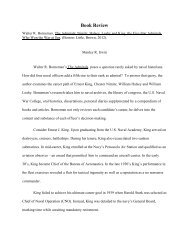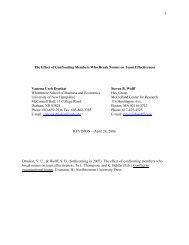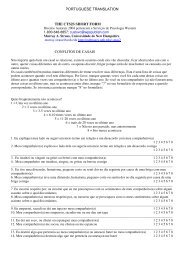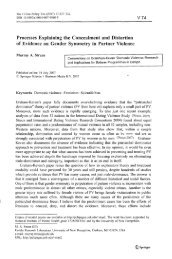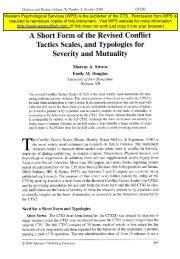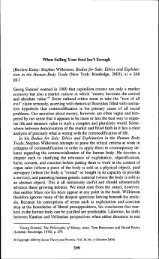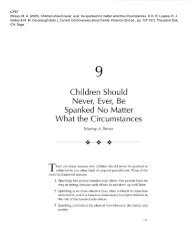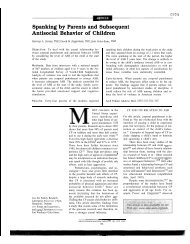SPANKING BY PARENTS: THE PRIMORDIAL VIOLENCE AND ITS ...
SPANKING BY PARENTS: THE PRIMORDIAL VIOLENCE AND ITS ...
SPANKING BY PARENTS: THE PRIMORDIAL VIOLENCE AND ITS ...
You also want an ePaper? Increase the reach of your titles
YUMPU automatically turns print PDFs into web optimized ePapers that Google loves.
Soc 695 Family Violence Research In World Perspective Murray A. Straus<br />
<strong>SPANKING</strong> <strong>BY</strong> <strong>PARENTS</strong>: <strong>THE</strong> <strong>PRIMORDIAL</strong> <strong>VIOLENCE</strong><br />
<strong>AND</strong> <strong>ITS</strong> EFFECTS ON CHILDREN<br />
SIX QUESTIONS TO BE ADDRESSED<br />
1. WHAT IS CORPORAL PUNISHMENT (CP)?<br />
2. HOW PREVALENT IS CP <strong>BY</strong> <strong>PARENTS</strong> IN AROUND <strong>THE</strong><br />
WORLD?<br />
3. ARE CHILDREN WHO ARE SPANKED REALLY HARMED?<br />
4. IS CP SOMETIMES NECESSARY TO HAVE WELL-BEHAVED<br />
CHILDREN?<br />
5. WHAT ARE <strong>THE</strong> TRENDS IN USE OF CP?<br />
6. WHAT WOULD A WORLD WITHOUT CP BE LIKE?<br />
CP83 1
Question 1: WHAT IS CORPORAL PUNISHMENT (CP)?<br />
� A. USE OF PHYSICAL FORCE<br />
� B. WITH <strong>THE</strong> INTENTION OF CAUSING BODILY PAIN<br />
� C. BUT NOT INJURY<br />
� D. FOR PURPOSES OF CORRECTION OR CONTROL<br />
EXAMPLES<br />
•“SPANK,” “SMACK”<br />
•SLAP H<strong>AND</strong><br />
•SHAKE, SHOVE, JERK<br />
•GRAB OR SQUEEZE HARD<br />
•TWIST EAR<br />
etc.<br />
� IF C <strong>AND</strong> D ARE PRESENT:<br />
A LEGALLY PERMITTED TYPE OF PHYSICAL ATTACK<br />
CP83 2
CORPORAL PUNISHMENT HAS BEEN <strong>THE</strong> NORM<br />
FOR THOUS<strong>AND</strong>S OF YEARS, <strong>AND</strong> STILL IS<br />
ANCIENT ISRAEL: "He that spareth his rod hateth his son; but he that<br />
loveth him chasteneth him betimes Proverbs 13:24<br />
"This son of ours is stubborn and rebellious. He will not obey us. He is<br />
a glutton and a drunkard. Then all the men of the town shall stone him<br />
to death. Deuteronomy 22;12<br />
18 th CENTURY ENGL<strong>AND</strong>: "When they turned a year old..., they were<br />
taught to fear the rod and to cry softly...." (Susanna Wesley to her son<br />
John, the founder of the Methodist Church, cited in Miller and Swanson<br />
1958:10)<br />
2001-2006 – Next Slide<br />
CP83 3
PERCENT WHO AGREE “A GOOD HARD <strong>SPANKING</strong> IS SOMETIMES NECESSARY”<br />
ALL NATIONS MEDIAN: Total = 52 % Males = 56% Females = 51%<br />
High Half Of Nations Low Half Of Nations<br />
Total Male Female Total Male Female<br />
Taiwan 74.3 80.7 71.6 Australia 53.2 57.7 52.1<br />
Tanzania 71.1 71.6 68.4 Canada 51.7 55.2 50.2<br />
South Africa 67.6 61.0 67.2 Hungary 51.6 45.6 54.3<br />
Mexico 66.7 70.8 65.7 Iran 51.6 57.1 50.0<br />
Singapore 65.5 68.2 64.2 Greece 50.3 67.3 43.2<br />
United States 60.8 68.9 56.7 Lithuania 48.8 57.6 44.2<br />
Germany 60.1 63.8 58.5 Switzerland 45.2 52.6 41.6<br />
Hong Kong 60.1 65.4 57.9 Romania 42.0 56.7 40.4<br />
South Korea 59.0 63.5 56.4 Japan 35.1 45.0 25.4<br />
Russia 58.8 65.3 54.0 Guatemala 33.4 40.0 24.8<br />
China 58.4 64.7 54.9 Malta 33.3 45.9 28.8<br />
India 56.3 59.1 54.8 Venezuela 28.3 40.9 19.3<br />
Great Britain 55.0 62.3 53.6 Belgium 23.0 27.8 21.5<br />
New Zealand 54.4 51.3 55.4 Israel 23.0 23.8 22.7<br />
Australia 53.2 57.7 52.1 Portugal 20.8 27.7 16.9<br />
Canada 51.7 55.2 50.2 Brazil 19.3 25.0 16.4<br />
CP83<br />
In rank order of national context total (VS01_1)`<br />
4
Question 2: How<br />
prevalent is CP<br />
CP83 5
WORLD VISION STUDY OF<br />
CHILD ABUSE <strong>AND</strong> NEGLECT IN 5 COUNTRIES<br />
SAMPLE 971 household with a child at home in Romania, Kenya,<br />
Ghana, Thailand, and Brazil<br />
Stratified random sample. Mostly female respondents<br />
Hit your child with your<br />
hand<br />
Hit your child with a stick<br />
or belt<br />
Percent In Past Year<br />
Romania Kenya Thailand<br />
Iasi Cj CT M S Ghana BS P<br />
Brazil<br />
70 74 58 64 64 66 27 21 72<br />
42 53 22 70 82 84 70 75 % 41<br />
From: World Vision (2001) Crying Out: Children And Communities Speak on Abuse<br />
and Neglect, Appendix B.<br />
CP83 6
<strong>THE</strong><br />
<strong>PRIMORDIAL</strong><br />
<strong>VIOLENCE</strong><br />
Over 90% hit<br />
toddlers<br />
More than<br />
a third<br />
hit infants<br />
US national survey,<br />
1,000 children, Straus<br />
& Stewart, 1999<br />
One out of<br />
four are still<br />
hitting at<br />
age 16<br />
CP83 7
LOW SES<br />
<strong>PARENTS</strong><br />
HIT MORE,<br />
BUT NOT<br />
MUCH<br />
MORE<br />
CORPORAL PUNISHMENT OF CHILDREN AGE 7-9,<br />
SAO PAULO, BRAZIL, 1999 (N=271)<br />
45%<br />
40%<br />
35%<br />
30%<br />
25%<br />
20%<br />
15%<br />
10%<br />
5%<br />
0%<br />
LOW HUMAN DEVELOPMENT INDEX<br />
AREA<br />
HIGH HUMAN DEVELOPMENT INDEX<br />
AREA<br />
SPANK, SLAP SHOVE, KICK PULL EAR, HAIR BELT, BRUSH PUNCH, SOCK<br />
MARIA AMELIA AZEVEDO <strong>AND</strong> VIVIANNE NORGUIRA DE<br />
AZEVEDO GUERRA, 2001 HITTING MANIA. SAO PAULO:<br />
IGLU EDITORIA<br />
CP83 8<br />
AVEZEDO1
RATES FROM INTERVIEWING A NATIONAL SAMPLE OF CHILDREN, 2007*<br />
* Harris Internet Youth Survey<br />
CP83 9
CP83 10
SOME O<strong>THE</strong>R CORPORAL PUNISHMENT RATES<br />
Chile 85.7% children in public schools<br />
54.1% children in private school<br />
(Vargas, Lopez, Perez, Zuniga, Toro & Ciocca, 1995)<br />
Egypt 72.9% children over 10, past year (Youssef, Attia & Kamel, 1998b)<br />
Italy 76.8% (Bardi & Borgognini-Tarli, 2001)<br />
India 76.4% (Hunter, Jain, Sadowski & Sanhueza, 2000)<br />
Mexico 74.9% (Frias-Armenta & McCloskey, 1998)<br />
Jamaica *79% of mothers beat their two to five year olds with an implement<br />
* 87% children age 11-12 ever<br />
* 70% in the previous four weeks (N=1,172, Samms-Vaugham et al 2004)<br />
(Sample of 75 economically deprived families, Landman, Grantham-<br />
McGregor & Desai, 1983)<br />
CP83 11
32 Nations In<br />
the International<br />
Dating<br />
Violence<br />
Study<br />
PERCENT SPANKED OR HIT A LOT BEFORE AGE 12<br />
ALL NATIONS MEDIAN: Total = 52, Males = 55, Females = 50<br />
High Half Of Nations Low Half Of Nations<br />
Total Male Female Total Male Female<br />
Taiwan 74.3 80.7 71.6 Australia 53.2 57.7 52.1<br />
Tanzania 71.1 71.6 68.4 Canada 51.7 55.2 50.2<br />
South Africa 67.6 61.0 67.2 Hungary 51.6 45.6 54.3<br />
Mexico 66.7 70.8 65.7 Iran 51.6 57.1 50.0<br />
Singapore 65.5 68.2 64.2 Greece 50.3 67.3 43.2<br />
United States 60.8 68.9 56.7 Lithuania 48.8 57.6 44.2<br />
Germany 60.1 63.8 58.5 Switzerland 45.2 52.6 41.6<br />
Hong Kong 60.1 65.4 57.9 Romania 42.0 56.7 40.4<br />
South Korea 59.0 63.5 56.4 Japan 35.1 45.0 25.4<br />
Russia 58.8 65.3 54.0 Guatemala 33.4 40.0 24.8<br />
China 58.4 64.7 54.9 Malta 33.3 45.9 28.8<br />
India 56.3 59.1 54.8 Venezuela 28.3 40.9 19.3<br />
Great Britain 55.0 62.3 53.6 Belgium 23.0 27.8 21.5<br />
New Zealand 54.4 51.3 55.4 Israel 23.0 23.8 22.7<br />
Australia 53.2 57.7 52.1 Portugal 20.8 27.7 16.9<br />
Canada 51.7 55.2 50.2 Brazil 19.3 25.0 16.4<br />
CP83<br />
In rank order of national context total (VS01_1)<br />
12
CONCLUSION:<br />
CHILDREN IN MOST OF <strong>THE</strong> WORLD, ARE<br />
BROUGHT UP MORE VIOLENTLY<br />
THAN IS GENERALLY REALIZED<br />
• MORE PREVALENT 94% of toddlers spanked (USA & UK)<br />
• MORE CHRONIC 3+ Times a week for toddlers<br />
• MORE SEVERE 28% Used a paddle, belt, etc.<br />
• LONGER DURATION 13 years for a third of US Children<br />
17 years for 14% of US children<br />
CP83 13
Question 3: ARE CHILDREN WHO ARE SPANKED<br />
REALLY HARMED?<br />
<strong>THE</strong> RESEARCH SHOWS THAT CP:<br />
* Lowers the chances of many things all parents want for their their<br />
children<br />
* Increases the risk of many serious and life-long life long problems<br />
<strong>PARENTS</strong> CAN’T SEE WHAT <strong>THE</strong> RESEARCH SHOWS BECAUSE<br />
* They have no way to know what the child will be like in the future<br />
* Research can find this out because based on following children<br />
for years<br />
* Therefore: Parents have to go on the basis of research which<br />
shows the harmful side effects of spanking<br />
LIKE SMOKERS WHO ALSO CAN'T SEE WHAT <strong>THE</strong> EFFECTS ARE<br />
Both smokers and parents can only get information on the<br />
benefits of stopping from research<br />
CP83 14
WHAT <strong>THE</strong> RESEARCH SHOWS<br />
ABOUT <strong>THE</strong> EFFECTS OF <strong>SPANKING</strong><br />
• Slows mental development<br />
• Reduces academic performance in elementary school<br />
• Increases anger and aggressiveness<br />
• Increases probability of Depression<br />
• Lowers occupational achievement and income<br />
• Increases probability of violence against dating and marital<br />
partners<br />
• Increases probability of physical abuse of a child<br />
RESULTS FROM SOME OF <strong>THE</strong> STUDIES SHOWING <strong>THE</strong>SE EFFECTS<br />
CP83 15
GROWTH IN<br />
COGNITIVE ABILITY<br />
OF CHILDREN<br />
TWO YEARS LATER<br />
* Not spanked:<br />
increased faster than<br />
average<br />
AVERAGE<br />
Data from the National<br />
Longitudinal Survey Of<br />
Youth. 1,510 children<br />
CHANGE IN SCORE 1986-90<br />
6<br />
5<br />
4<br />
3<br />
2<br />
1<br />
0<br />
-1<br />
-2<br />
-3<br />
NONE<br />
CP83 16<br />
ONCE<br />
CP41CHART 3 COGNITIVE<br />
AGE 2-4<br />
AGE 5-9<br />
TWICE<br />
CORPORAL PUNISHMENT IN TWO SAMPLE WEEKS<br />
3+
CP83 17
SPANKED<br />
The more spanking<br />
the more antisocial<br />
behavior two years<br />
later<br />
NOT SPANKED<br />
Antisocial behavior<br />
measured two years<br />
later decreased<br />
CHANGE<br />
IN<br />
ANTI-<br />
SOCIAL<br />
BEHAVIOR<br />
*<br />
20<br />
15<br />
10<br />
5<br />
0<br />
-5<br />
FIGURE 1. CHANGE IN ANTISOCIAL BEHAVIOR<br />
FROM 1988 TO 1990 <strong>BY</strong> <strong>SPANKING</strong> IN 1988<br />
(CHILDREN 6-9) )<br />
EURO-AMER.<br />
MINORITY<br />
NONE ONCE TWICE THREE +<br />
TIMES SPANKED IN PREVIOUS WEEK<br />
* ADJUSTED FOR TIME-1 ANTISOCIAL BEHAVIOR, COGNITIVE STIMULATION <strong>AND</strong><br />
CP83 EMOTIONAL SUPPORT <strong>BY</strong> <strong>THE</strong> MO<strong>THE</strong>R, CHILD GENDER, <strong>AND</strong><br />
SOCIOECONOMIC STATUS. CP67-1 ANTISOCIAL<br />
18
CHILDREN IN SIX<br />
DIVERSE NATIONS<br />
<strong>THE</strong> MORE CORPORAL<br />
PUNISHMENT<br />
<strong>THE</strong> MORE:<br />
• MORE AGGRESSION<br />
• MORE ANXIETY<br />
Lansford, J. E. et al (2005). Physical<br />
Discipline and Children’s Adjustment:<br />
Cultural Normativeness as a Moderator.<br />
Child Development.<br />
CP83 19
CP83 20
CP83 21
<strong>BY</strong><br />
PARENT<br />
<strong>THE</strong> MORE CORPORAL PUNISHMENT,<br />
<strong>THE</strong> GREATER <strong>THE</strong> PROBABILITY OF<br />
PHYSICALLY ABUSING A CHILD<br />
CP83 22<br />
OF PARENT
<strong>THE</strong>SE ARE ALL “RISK FACTORS,”<br />
NOT ONE-TO-ONE LINKS<br />
• A CONDITION WHICH INCREASES <strong>THE</strong> PROBABILITY OF A<br />
DISEASE OR PROBLEM<br />
• EXAMPLES:<br />
– SMOKING <strong>AND</strong> DEATH FROM SMOKING RELATED DISEASE<br />
(33% chance of death from a smoking related disease – which<br />
means that 64% do not)<br />
– FREQUENT <strong>SPANKING</strong> <strong>AND</strong> DELINQUENCY<br />
(24% chance - 5 fold increase, but 76% do not become<br />
delinquent)<br />
– BINGE DRINKING <strong>AND</strong> WIFE BEATING<br />
(19% chance - 3 fold increase, but 81% of binge drinkers do not<br />
beat their wives)<br />
CP83 23
Question 4.<br />
IS CP<br />
NECESSARY TO<br />
HAVE WELL-<br />
BEHAVED<br />
CHILDREN?<br />
SHORT RUN<br />
EFFECTIVE-<br />
NESS:<br />
CP “WORKS”<br />
BUT NO BETTER<br />
THAN O<strong>THE</strong>R<br />
METHODS<br />
HOURS<br />
TO<br />
REPET-<br />
ITION<br />
10<br />
9<br />
8<br />
7<br />
6<br />
5<br />
4<br />
3<br />
2<br />
1<br />
0<br />
FIGURE 3. HOURS TO REPITITON OF MISBEHAVIOR <strong>BY</strong><br />
40 CHILDREN AGE 2-3<br />
CORPORAL<br />
PUNISH ONLY<br />
CORPORAL<br />
PUNISH +<br />
REASONING<br />
FIGHTS AGAIN<br />
NON-<br />
CORPORAL<br />
PUNISH<br />
REASONING<br />
ONLY<br />
TYPE OF DISCIPLINE<br />
REASONING +<br />
FORCED<br />
COMPLINACE<br />
2,853 INSTANCES OF DISOBEDIANCE, 785 INSTANCES OF FIGHTING<br />
CP67-3 LARZELERE (FROM LARZELERE & MIR<strong>AND</strong>A, TABLES 2 & 3)<br />
REASONING +<br />
NON-<br />
CORPORAL<br />
PUNISH<br />
CP83 24
LONG-RUN<br />
EFFECTIVENESS:<br />
CP BOOMERANGS<br />
CP83 25
CHANGE<br />
IN<br />
ANTISOCIAL<br />
BEHAVIOR<br />
NOT<br />
SPANKED:<br />
BEHAVIOR<br />
IMPROVED<br />
*<br />
20<br />
15<br />
10<br />
5<br />
0<br />
-5<br />
FIGURE 1. CHANGE IN ANTISOCIAL BEHAVIOR<br />
FROM 1988 TO 1990 <strong>BY</strong> <strong>SPANKING</strong> IN 1988<br />
(CHILDREN 6-9) )<br />
EURO-AMER.<br />
MINORITY<br />
NONE ONCE TWICE THREE +<br />
TIMES SPANKED IN PREVIOUS WEEK<br />
SPANKED:<br />
BEHAVIOR<br />
GOT WORSE<br />
* ADJUSTED FOR TIME-1 ANTISOCIAL BEHAVIOR, COGNITIVE STIMULATION <strong>AND</strong><br />
CP83 EMOTIONAL SUPPORT <strong>BY</strong> <strong>THE</strong> MO<strong>THE</strong>R, CHILD GENDER, <strong>AND</strong><br />
SOCIOECONOMIC STATUS. CP67-1 ANTISOCIAL<br />
26
TWO REASONS<br />
WHY CP MAKES<br />
THINGS WORSE IN<br />
<strong>THE</strong> LONG RUN<br />
1. LESS WELL<br />
DEVELOPED<br />
CONSCIENCE<br />
CP83 27
2. WEAKENS<br />
BOND TO<br />
PARENT<br />
FIG A. CLOSENESS OF CHILD TO MO<strong>THE</strong>R<br />
<strong>BY</strong> CORPORAL PUNISHMENT<br />
(713 CHILDREN AGE 5-18 IN TW O MINNESTA CITIES)<br />
BONDING SCALE *<br />
54<br />
52<br />
50<br />
48<br />
46<br />
44<br />
42<br />
40<br />
BONDING2A BONDING3A<br />
. NONE ONCE 3-5 6 +<br />
.<br />
TIMES SPANKED IN PREVIOUS SIX<br />
MONTHS<br />
*ADJUSTED FOR AGE, GENDER OF CHILD, <strong>AND</strong> SOCIOECONOMIC STATUS,<br />
CP83 28<br />
CP40A
SOME O<strong>THE</strong>R REASONS LONG TERM<br />
EFFECTIVENESS OF CP IS LOW<br />
* FROM SCHOOL AGE ON -- OUT OF SIGHT MOST OF <strong>THE</strong> TIME<br />
* CHILDREN GET "TOO BIG" <strong>THE</strong>N WHAT?<br />
* LESS OPPORTUNITY TO LEARN HOW TO GET NEEDS FILLED <strong>BY</strong><br />
EXPLAINING<br />
NEGOTIATING<br />
CREATIVE ALTERNATIVES<br />
COMPROMISE<br />
C:\My Documents\A2\CHARTS\CP\EFFECTIV\EFFECTIV 2D.doc<br />
CP83 29
Question 5:<br />
WHAT ARE<br />
<strong>THE</strong> TRENDS<br />
IN USE OF<br />
CP?<br />
CP83 30<br />
(USA)
CP83 31
<strong>THE</strong> MOST<br />
CHANGE HAS<br />
BEEN IN<br />
SWEDEN<br />
CP83 32
UNITED NATIONS<br />
SECOND WORLD SUMMIT ON CHILDREN<br />
“All countries to adopt legislation, policies and<br />
programmes to protect children from all forms of violence,<br />
whether at home, in school or in the community”: and<br />
“protect children from torture and other cruel, inhuman or<br />
degrading treatment, including corporal punishment”.<br />
CP83 33
HITTING CHILDREN BANNED IN <strong>THE</strong>SE COUNTRIES<br />
As of 2006<br />
15 <strong>BY</strong> STATUTE<br />
Austria<br />
Bulgaria<br />
Croatia<br />
Cyprus<br />
Denmark<br />
Finland<br />
Germany<br />
Hungary<br />
Iceland<br />
Israel<br />
Latvia<br />
Norway<br />
Romania<br />
Sweden<br />
Ukraine<br />
<strong>BY</strong> HIGH COURT RULING:<br />
Israel, Italy<br />
Steps to implement<br />
vary from almost none<br />
to very extensive<br />
CP83 34
QUESTION 6: WHAT <strong>THE</strong> WORLD MIGHT BE LIKE IF<br />
ADULTS STOPPED <strong>SPANKING</strong>?<br />
<strong>THE</strong> EXAMPLE OF SWEDEN<br />
(Durrant, 1998)<br />
• CP in schools banned in 1928;<br />
• CP by parents banned in 1979 (but no criminal penalties)<br />
<strong>VIOLENCE</strong> AGAINST CHILDREN SINCE 1979 BAN<br />
• Public approval of CP declined to near zero<br />
• Use of CP declined sharply but continues<br />
• Child physical abuse has not increased<br />
(Child abuse deaths remain lowest in the world)<br />
• Reports of CP increased as a result of intervention effort<br />
YOUTH CRIME <strong>AND</strong> PROBLEMS SINCE 1979 BAN:<br />
• Crime rates decreased<br />
• Alcohol and drug use decreased<br />
• Suicide decreased<br />
• Reports of assault by youth increased – reflects redefinition of bullying as<br />
assault and zero tolerance<br />
CP83 35
<strong>THE</strong>SE ARE ALL “RISK FACTORS,”<br />
NOT ONE-TO-ONE LINKS<br />
• A CONDITION WHICH INCREASES <strong>THE</strong> PROBABILITY OF A<br />
DISEASE OR PROBLEM<br />
• EXAMPLES:<br />
– SMOKING <strong>AND</strong> DEATH FROM SMOKING RELATED DISEASE<br />
(33% chance of death from a smoking related disease – which<br />
means that 64% do not)<br />
– FREQUENT <strong>SPANKING</strong> <strong>AND</strong> DELINQUENCY<br />
(24% chance - 5 fold increase, but 76% do not become<br />
delinquent)<br />
– BINGE DRINKING <strong>AND</strong> WIFE BEATING<br />
(19% chance - 3 fold increase, but 81% of binge drinkers do not<br />
beat their wives)<br />
CP83 36
Chart 5-4.1 Comparison of the Effect of Corporal Punishment<br />
With Effects From Other Domains<br />
Smoking and lung cancer<br />
Media violence and<br />
aggression<br />
CP and cognitive<br />
development*<br />
Condom use and sexually<br />
transmitted HIV<br />
CP and adult criminal<br />
behavior among men*<br />
Passive smoking and lung<br />
cancer at work<br />
Exposure to lead and IQ<br />
scores in children<br />
Nicotine patch and<br />
smoking cessation<br />
Calcium intake and bone<br />
mass<br />
Homework and academic<br />
achievement<br />
Exposure to asbestos and<br />
laryngeal cancer<br />
Self-examination and<br />
extent of breast cancer<br />
0 0.1 0.2<br />
Correlation<br />
0.3 0.4<br />
* Partial correlation. See Appendix 5 for explanation, Other effect sizes are from Bushman, B. J.,<br />
& Anderson, C. A. (2001). Media violence and the American public: Scientific facts versus media<br />
misinformation. American Psychologist, 56(6/7), 477-489.<br />
CP83 37
WHY ENDING CP<br />
CAN BE A MAJOR<br />
BENEFIT FOR<br />
CHILDREN <strong>AND</strong><br />
SOCIETY<br />
CP83 38
QUESTION 6 AGAIN: WHAT WOULD <strong>THE</strong> WORLD<br />
BE LIKE IF ADULTS STOPPED <strong>SPANKING</strong>?<br />
FOR <strong>PARENTS</strong><br />
* LESS HASSLE<br />
* LESS BETTER BEHAVED CHILDREN<br />
FOR CHILDREN<br />
* LESS RISK OF PHYSICAL ABUSE<br />
* LESS DELINQUENCY<br />
* ENHANCED MENTAL ABILITY <strong>AND</strong> SCHOOL ACHIEVEMENT<br />
FOR <strong>THE</strong> NEXT GENERATION<br />
* LESS “STREET <strong>VIOLENCE</strong>”<br />
* LESS DEPRESSION <strong>AND</strong> SUICIDE<br />
* LESS WIFE BEATING<br />
* HIGHER ECONOMIC ACHIEVMENT<br />
A LESS VIOLENT, HEALTHIER, WEALTHIER, <strong>AND</strong> WISER WORLD<br />
CP83 39
END<br />
CP83 40
A FEW REFERENCES<br />
Giles-Sims, J., Straus, M. A., & Sugarman, D. B. (1995). Child, maternal and family<br />
characteristics associated with spanking. Family Relations, 44(2), 170-176.<br />
Greven, P. (1990). Spare the child: The religious roots of punishment and the<br />
psychological impact of physical abuse. New York: Alfred A. Knopf.<br />
Gershoff, E. T. (2002). Corporal punishment by parents and associated child behaviors<br />
and experiences: A meta-analytic and theoretical review. Psychological Bulletin,<br />
128(4), 539-579.<br />
Simons, R. L., Lin, K.-H., & Gordon, L. C. (1998). Socialization in the Family of origin<br />
and male dating violence: A prospective study. Journal of Marriage and the<br />
Family, 60(2), 467-478.<br />
Straus, M. A. (1995). Corporal punishment of children and depression and suicide in<br />
adulthood. In J. McCord (Ed.), Coercion and Punishment in Long Term<br />
Perspective. New York, New York: Cambridge University Press.<br />
Straus, M. A. (2005). Children should never, ever, be spanked no matter what the<br />
circumstances. In R. J. Gelles & D. R. Loseke (Eds.), Current Controversies<br />
about Family Violence (2nd ed., pp. chapter 9). Thousand Oak, CA: Sage.<br />
Straus, M. A. (2007 in press). The primordial violence: Corporal punishment by parents,<br />
cognitive development, and crime. Walnut Creek, CA: Alta Mira Press.<br />
Straus, M. A., Sugarman, D. B., & Giles-Sims, J. (1997). Spanking by parents and<br />
subsequent antisocial behavior of children. Archives of pediatric and adolescent<br />
medicine, 151(August), 761-767.<br />
CP83 41
FOR EVIDENCE ON ALL<br />
<strong>THE</strong>SE POINTS <strong>AND</strong><br />
MANY O<strong>THE</strong>RS see<br />
* This book<br />
* Papers on my website<br />
(1 st slide)<br />
* References on last<br />
slide<br />
* ALSO Forthcoming<br />
book<br />
CP83 42
I. <strong>SPANKING</strong> -- <strong>THE</strong> VIRTUOUS<br />
<strong>VIOLENCE</strong><br />
1. The Conspiracy of Silence<br />
2. Everyone Does It, But Less Now<br />
3. Hitting Adolescents<br />
4. Who Spanks the Most?<br />
II. <strong>THE</strong> PRICE OF VIRTUE<br />
5. Depression and Suicide<br />
6. Physical Abuse<br />
7. Violence and Crime<br />
8. The Fusion of Sex and Violence<br />
9. Alienation and Reduced Income<br />
Ill. <strong>THE</strong> FUTURE<br />
10. Ten Myths that Perpetuate Corporal<br />
Punishment<br />
I I. Social Evolution and Corporal<br />
Punishment<br />
12. The Benefits of Never Spanking: New<br />
and More Definitive Evidence<br />
2 nd Edition, 2001<br />
Transaction Publishers<br />
390 Campus Drive<br />
Somerset, NJ 08873<br />
Toll free-US only 888-999-6778<br />
or 732-445-1245<br />
Fax. 732-748-9801<br />
www.transactionpub.com<br />
In UK and Europe:<br />
Transaction Publishers (UK)<br />
C/O EDS 3 Henrietta Street<br />
Covent Garden<br />
London WC2E 8LU<br />
Tel. +44 (0)20 7 240 0856<br />
Fax. +44 (0)20 7 379 0609<br />
CP83 43
Walnut Creek, CA: AltaMira Press, In Press 2007. www.altamirapress.com<br />
<strong>THE</strong> <strong>PRIMORDIAL</strong> <strong>VIOLENCE</strong>:<br />
CORPORAL PUNISHMENT <strong>BY</strong> <strong>PARENTS</strong>, COGNITIVE DEVELOPMENT,<br />
<strong>AND</strong> CRIME<br />
Murray A. Straus and Rose A. Medeiros<br />
University of New Hampshire murray.straus@unh.edu<br />
Part I. SOCIAL CAUSES <strong>AND</strong> CONTEXT<br />
1-1 Prevalence, Chronicity, And Severity of Corporal Punishmnt In The USA<br />
1-2 Corporal Punishment In The Lives Of University Students In 16 Countries<br />
1-3 There Was An Old Woman Who Lived In A Shoe – What Did She Do?<br />
1-4 Violent Attitudes and Cultural Norms Underling Corporal Punishment<br />
Part II. CHILD BEHAVIOR PROBLEMS<br />
2-1 Spanking To Control Antisocial Behavior - The Boomerang Effect<br />
2-2 The Effects of Impulsive Spanking and Never Spanking<br />
2-3 Corporal Punishment, the Child-To-Mother Bond, And Delinquency<br />
2-4 Corporal Punishment And Risky Sex<br />
3-1<br />
PART III. HUMAN CAPITAL<br />
Slowing Of Cognitive Development<br />
3-2 Lower Educational Achievement Test Scores<br />
3-3 Reduced Chances of College Graduation<br />
CP83 44
4-1<br />
Part IV. ADULT <strong>VIOLENCE</strong> <strong>AND</strong> O<strong>THE</strong>R CRIME<br />
Why Corporal Punishment Is Linked To Physically Assaulting A Spouse<br />
4-2 Corporal Punishment and Crime in Ethnic Group Context<br />
4-3 Corporal Punishment And Violence Against Dating Partners Worldwide<br />
4-4 Spanking and Crime in Adulthood By High Risk Children<br />
Chapter<br />
<strong>THE</strong> <strong>PRIMORDIAL</strong> <strong>VIOLENCE</strong> (CONTINUED)<br />
Part V. SOCIAL CHANGE <strong>AND</strong> TRENDS<br />
5-1 The Decline in Public Support Of Spanking<br />
5-2 Why Everyone Spanks Toddlers And What To Do About It<br />
5-3 Corporal Punishment And Societal Violence<br />
5-4 A World Without Spanking<br />
CP83 45
WHY PAY ATTENTION TO <strong>SPANKING</strong>?<br />
�MOST <strong>SPANKING</strong> IS DONE <strong>BY</strong> LOVING <strong>PARENTS</strong> TO CORRECT<br />
<strong>AND</strong> TRAIN CHILDREN<br />
�<strong>THE</strong> HARMFUL EFFECTS FOR AN INDIVIDUAL CHILD ARE SMALL<br />
COMPARED TO <strong>THE</strong> EFFECTS OF PHYSICAL ABUSE<br />
BUT<br />
�IT VIOLATES <strong>THE</strong> RIGHTS OF CHILDREN AS DEFINED IN <strong>THE</strong><br />
UNITED NATIONS CHARTER ON CHILDREN’S RIGHTS<br />
�A VERY LARGE PERCENTAGE OF CHILDREN ARE SPANKED<br />
�CHILDREN ARE TYPICALLY HIT FOR MANY YEARS – IN <strong>THE</strong> USA,<br />
ON AVERAGE UNTIL <strong>THE</strong>Y ARE ABOUT 12 YEARS OLD, I.E. FOR<br />
ABOUT 12 YEARS<br />
�<strong>THE</strong> EFFECT ON <strong>THE</strong> WELFARE OF CHILDREN IS VERY LARGE –<br />
GREATER THAN <strong>THE</strong> HARMFUL EFFECT OF PHYSICAL ABUSE<br />
CP83 46
Percent Who Spanked in Past<br />
Week<br />
Average Number Of Times per Week<br />
%<br />
80<br />
70<br />
60<br />
50<br />
40<br />
30<br />
20<br />
10<br />
0<br />
RELIGIOUS DIFFERENCES IN <strong>SPANKING</strong> CHILDREN 3-5<br />
CATHOLIC<br />
2.8 3.6 3.3 3.6<br />
NONE<br />
PROTESTANT<br />
O<strong>THE</strong>R<br />
Giles-Sims, Jean., Murray A. Straus, and David B. Sugarman. 1995. "Child, maternal and<br />
CP83 47<br />
family characteristics associated with spanking." Family Relations 44:170-176.<br />
`
CHINESE CORPORAL PUNISHMENT RATES<br />
Survey by the Guangdong Provincial Women's Federation<br />
• 54% of university and middle-school students experienced corporal<br />
punishment<br />
• 80% of parents and teachers believe corporal punishment has<br />
benefits<br />
Survey by the University of Hong Kong (2003-04)<br />
• 44% of parents had beaten their children to "straighten" them up.<br />
Joy Lu “Spare the rod and spoil the child?” China Daily 05/27/2006 page 3 (downloaded from internet)<br />
CP83 48
TWO CANADIAN STUDIES<br />
ONTARIO HEALTH SURVEY 83% IN CHILDHOOD<br />
R<strong>AND</strong>OM SAMPLE OF<br />
PERSONS AGE 15-44<br />
R<strong>AND</strong>OM SAMPLE OF TORONTO 75% IN PAST YEAR<br />
MO<strong>THE</strong>RS WITH CHILD<br />
AGE 3 TO 17 AT HOME<br />
Lenton, Rhonda L. 1990. “Techniques of child discipline and abuse by parents.” Canadian<br />
Review of Sociology & Anthropology 27:157-185.<br />
MacMillan, Harriet L., Michael H. Boyle, Maria Y-Y. Wong, Eric K. Duku, Jan E. Fleming, and<br />
Christine A. Walsh. 1999. “Slapping, spanking and lifetime psychiatric disorder in a<br />
community sample of Ontario residents.” Canadian Medical Association Journal<br />
161:805-809.<br />
CP83 49<br />
C:\My Documents\A2\CHARTS\CP\INTERNATIONAL\TWO CANADIAN STUDIES.DOC
CORPORAL PUNISHMENT IN TRIBAL<br />
SOCIETIES<br />
• 77% USED CP<br />
NTHROPOLOGISTS REPORTS ON 186 SOCIETIES (BARRY,<br />
T AL, 1980)<br />
CP83 50<br />
C:\My Documents\A2\CHARTS\CP\INTERNATIONAL\Tribal Society Rates.doc
HOW MUCH COULD ENDING CORPORAL PUNISHMENT REDUCE<br />
CRIMINAL VICTIMIZATION?<br />
A. JUVENILE VICTIMS<br />
CORPORAL<br />
PUNISHMENT<br />
HIGH NONE CHANGE<br />
REPEATEDLY <strong>AND</strong> SEVERELY ATTACKED <strong>BY</strong> A 40% 18% 55% LESS<br />
SIBLING IN PREVIOUS 12 MONTHS (p.102)<br />
NUMBER OF TIMES HIT <strong>BY</strong> CHILDREN 4.3 2.1 51% LESS<br />
IN SCHOOL IN TWO WEEK PERIOD (MEAN)<br />
(Strasbourg et al 1994)<br />
JUVENILE DELINQUENCY IN PAST 12 MONTHS 15% 3% 80% LESS<br />
(p.108)<br />
B. ADULT VICTIMS<br />
SPOUSES HIT IN PREVIOUS 12 MONTHS 25% 8% 68% LESS<br />
(p.104)<br />
PHYSICALLY ABUSED CHILDREN 24% 8% 67% LESS<br />
12 MONTHS (i.e. went beyond legal<br />
corporal punishment) (p.94)<br />
CONVICTIONF FOR AN INDEX CRIME 33% 14% 58% LESS<br />
Sons of non-criminal fathers. Cambride-Somerville<br />
Youth Study (McCord, 1991)<br />
CP83<br />
C:\MyDocuments\A2\CHARTS\CP\EFFECTS\Crime,Violence\ADDED RISK-CRIME.d oc<br />
51
CP83 52
EFFECTIVENESS OF CORPORAL PUNISHMENT<br />
COMPARED TO NON-CORPRAL DISCIPLINE<br />
AVERAGE EFFECTIVNESS<br />
TIME SPAN CORP PUN NON-CP<br />
IMMEDIATE HIGH HIGH<br />
SHORT TERM (HOURS, DAYS) LOW LOW<br />
LONG TERM (MONTHS, YEARS) MAKES HIGH<br />
WORSE<br />
SIDE EFFECTS HARMFUL BENIFICAL<br />
C:\My Documents\A2\CHARTS\CP\EFFECTIV\EFFECTIVE SUMMARY.DOC<br />
CP83 53
The “terrible two’s”<br />
CP83 54
%<br />
PERCENT WHO USED CORPORAL<br />
PUNISHEMNT ON CHILDREN IN PRIVATE <strong>AND</strong><br />
STATE SCHOOLS, CHILE (Vargas et al, 1995)<br />
90<br />
80<br />
70<br />
60<br />
50<br />
40<br />
30<br />
20<br />
10<br />
0<br />
Parent's report Child's report<br />
Private State<br />
CP83 55
NATION<br />
& REF.<br />
CANADA<br />
MACMILLAN ET AL,<br />
1999<br />
CANADA<br />
LENTON, 1990<br />
ENGL<strong>AND</strong><br />
NEWSON &<br />
NEWSON, 1963<br />
ENGL<strong>AND</strong><br />
NOBES & SMITH,<br />
1997<br />
SWEDEN<br />
STATTIN ET ALL,<br />
1995<br />
B. SOME O<strong>THE</strong>R COUNTRIES<br />
SAMPLE<br />
CHILD %<br />
& N<br />
AGE HIT TIME<br />
ONTARIO<br />
RECALL OF 84% EVER<br />
R<strong>AND</strong>OM SAMPLE CHILDHOOD<br />
TORONTO<br />
R<strong>AND</strong>OM<br />
SAMPLE<br />
NOTTINGHAM<br />
R<strong>AND</strong>OM SAMPLE<br />
N=709<br />
Age 3 - 17 75% YEAR<br />
INFANTS<br />
Age 4<br />
N=99 Age 1 – 11<br />
STOCKHOLM<br />
BIRTH COHORT<br />
1955-58<br />
Age 4<br />
Age 3<br />
62%<br />
97%<br />
80%<br />
52%<br />
94%<br />
YEAR<br />
YEAR<br />
YEAR<br />
WEEK<br />
YEAR<br />
MEAN<br />
TIMES<br />
CP83 56<br />
C:\My Documents\A2\CHARTS\CP\INTERNATIONAL\INTERNATIONAL RATES 2.doc<br />
--<br />
--<br />
75% AT<br />
LEAST<br />
ONCE A<br />
WEEK<br />
33% AT<br />
LEAST<br />
DAILY
WHY LONG TERM EFFECTIVENESS IS LOW<br />
* NOT AS EFFECTIVE IN DEVELOPING CONSCIENCE (NEXT SLIDE)<br />
Need to be good if mommy or daddy are watching or will know, not on<br />
basis of what is right and wrong<br />
* UNDERCUTS BOND TO PARENT (NEXT SLIDE)<br />
* FROM SCHOOL AGE ON -- OUT OF SIGHT MOST OF <strong>THE</strong> TIME<br />
* CHILDREN GET "TOO BIG" <strong>THE</strong>N WHAT?<br />
* LESS OPPORTUNITY TO LEARN HOW TO GET NEEDS FILLED <strong>BY</strong><br />
EXPLAINING<br />
NEGOTIATING<br />
CREATIVE ALTERNATIVES<br />
COMPROMISE<br />
C:\My Documents\A2\CHARTS\CP\EFFECTIV\EFFECTIV 2D.doc<br />
CP83 57
Question 4. IS CP SOMETIMES NECESSARY TO HAVE WELL-<br />
BEHAVED CHILDREN?<br />
ANSWER DEPENDS ON HOW EFFECTIVE CP IS IN<br />
CORRECTING MISBEHAVIOR<br />
CP83 C:\My Documents\A2\CHARTS\CP\EFFECTIV\EFFECTIV 2A.doc<br />
58




